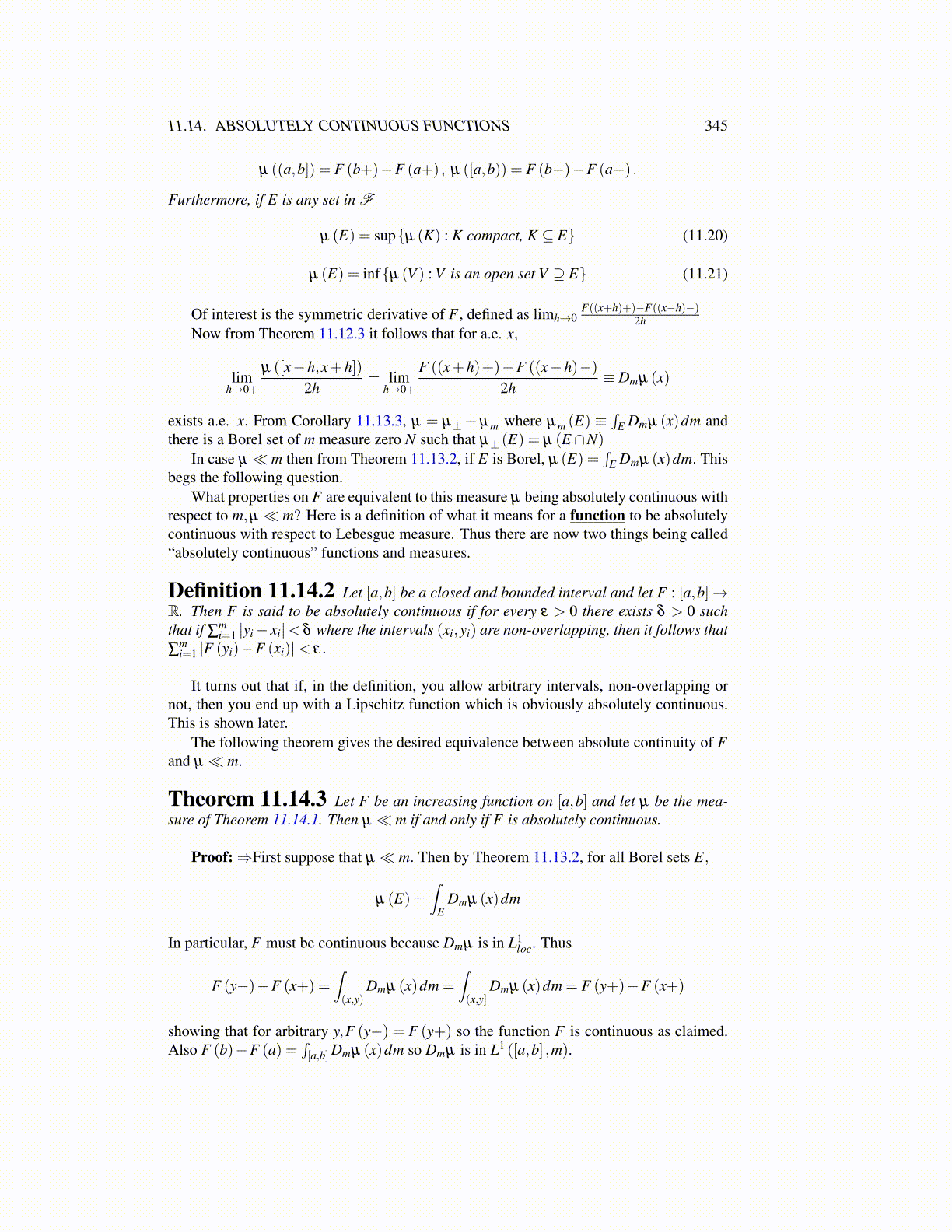
11.14. ABSOLUTELY CONTINUOUS FUNCTIONS 345
µ ((a,b]) = F (b+)−F (a+) , µ ([a,b)) = F (b−)−F (a−) .
Furthermore, if E is any set in F
µ (E) = sup{µ (K) : K compact, K ⊆ E} (11.20)
µ (E) = inf{µ (V ) : V is an open set V ⊇ E} (11.21)
Of interest is the symmetric derivative of F , defined as limh→0F((x+h)+)−F((x−h)−)
2hNow from Theorem 11.12.3 it follows that for a.e. x,
limh→0+
µ ([x−h,x+h])2h
= limh→0+
F ((x+h)+)−F ((x−h)−)2h
≡ Dmµ (x)
exists a.e. x. From Corollary 11.13.3, µ = µ⊥+ µm where µm (E) ≡∫
E Dmµ (x)dm andthere is a Borel set of m measure zero N such that µ⊥ (E) = µ (E ∩N)
In case µ ≪ m then from Theorem 11.13.2, if E is Borel, µ (E) =∫
E Dmµ (x)dm. Thisbegs the following question.
What properties on F are equivalent to this measure µ being absolutely continuous withrespect to m,µ ≪ m? Here is a definition of what it means for a function to be absolutelycontinuous with respect to Lebesgue measure. Thus there are now two things being called“absolutely continuous” functions and measures.
Definition 11.14.2 Let [a,b] be a closed and bounded interval and let F : [a,b]→R. Then F is said to be absolutely continuous if for every ε > 0 there exists δ > 0 suchthat if ∑
mi=1 |yi− xi|< δ where the intervals (xi,yi) are non-overlapping, then it follows that
∑mi=1 |F (yi)−F (xi)|< ε.
It turns out that if, in the definition, you allow arbitrary intervals, non-overlapping ornot, then you end up with a Lipschitz function which is obviously absolutely continuous.This is shown later.
The following theorem gives the desired equivalence between absolute continuity of Fand µ ≪ m.
Theorem 11.14.3 Let F be an increasing function on [a,b] and let µ be the mea-sure of Theorem 11.14.1. Then µ ≪ m if and only if F is absolutely continuous.
Proof:⇒First suppose that µ ≪ m. Then by Theorem 11.13.2, for all Borel sets E,
µ (E) =∫
EDmµ (x)dm
In particular, F must be continuous because Dmµ is in L1loc. Thus
F (y−)−F (x+) =∫(x,y)
Dmµ (x)dm =∫(x,y]
Dmµ (x)dm = F (y+)−F (x+)
showing that for arbitrary y,F (y−) = F (y+) so the function F is continuous as claimed.Also F (b)−F (a) =
∫[a,b] Dmµ (x)dm so Dmµ is in L1 ([a,b] ,m).